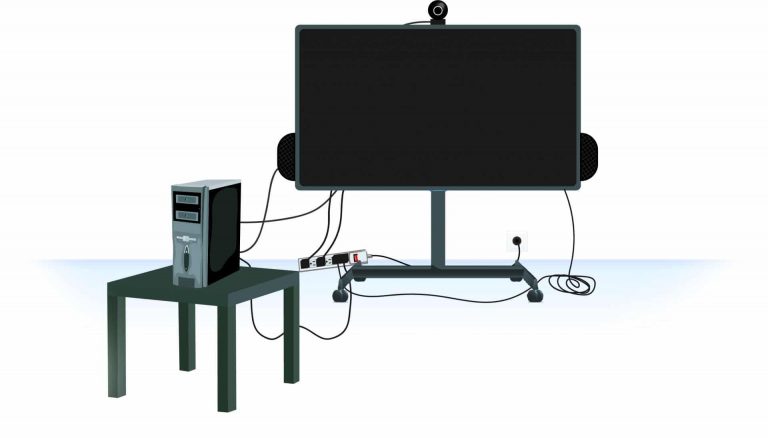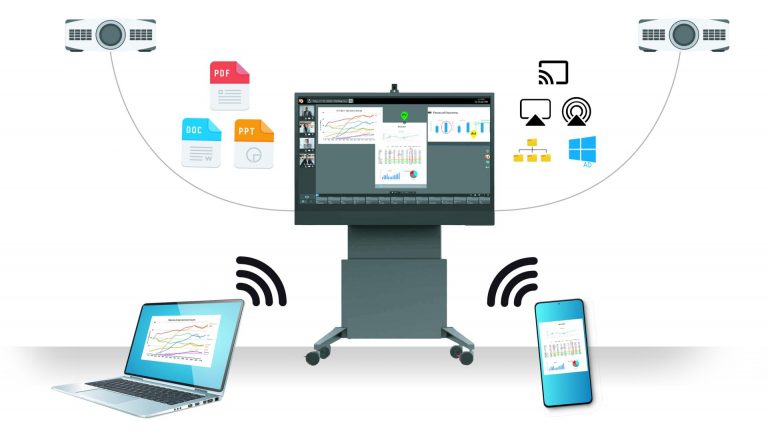The Need For An Integrated Boardroom
The Ideal Appliance for Your Conference Room
MISSISSAUGA, ONTARIO, April 22, 2020
The future of work is here! The promises of the ‘digital revolution’ are within our grasp: remote workforce, diversity, adaptability, efficiency – all within the digital environment. But before we get to realize these promises, IT organizations, in particular, must suffer through numerous problems: sophisticated technology, complexity and lack of interoperability, and integration headaches.
Meetings are an essential part of our business lives. Recent US stats indicate that on average 37% of employee time is spent in meetings, with some busy professionals attending over 60 meetings per month. The demand for virtual meetings is increasing for a good reason: a five-person meeting conducted in-person and involving travel is much more expensive than a meeting conducted by audio or video conference.
Part of building the future work environment, therefore, is creating a state-of-the-art conference room system with effective audio-visual capability. That doesn’t mean you have to invest in complex and expensive technologies. You just have to create a space that facilitates effective interaction and collaboration. Virtual collaboration must be simple, seamless, and intuitive for both on-site and remote users. Poorly implemented technology is doomed to collect the proverbial dust and sit in the corner without generating a return on capital.
The challenges of building a state-of-the-art conference room; a piece meal DIY approach versus an out-of-the-box solution; what you should look for and what you should avoid; these are some of the issues we will explore in this paper.
The Challenges
There is a dizzying array of technology trying to fit into the modern conference space. Everything from flat panel displays, projectors and interactive white boards to wireless dongles. HDMI capture cards, microphones, speakers and webcams also need to be installed and managed. Wireless connectivity standards such as Airplay, Chromecast, and Miracast must be combined with HDMI input and sometimes control systems such as Crestron or similar products in an attempt to tie various technologies together.
Getting disparate hardware to play well together is just the tip of the iceberg. The digital revolution doesn’t mean that you just rely on email, Slack, and webchats for a complete solution. Those tools can help you communicate, but they are not designed for sharing ideas, brainstorming or resolving conflicts, which are often critical functions for any team. For that, you need to use advanced products that make your teams feel like they are there in the same room.
Trying to get everything working in a manner that is intuitive to the end user, and which results in a dramatic reduction of the utilization of the conference room equipment can feel like an insurmountable challenge. So what is one to do?
The “DIY” Solution
Do It Yourself — DIY — is a popular solution used by many all around the world. Achieving a desired end goal successfully is appealing, and the satisfaction that comes from such an accomplishment is real. But should a conference room solution have to be DIY? We’ve outlined some of the pitfalls above, but still can be tempting to create a DIY solution and save costs. There may be a few advantages to this method, as you get to pick and choose the best components, the vendors, and tailor the solution to your needs. You may also perceive an opportunity to reduce costs by negotiating directly with the vendors.
As previously noted, there are many potential pitfalls to this method. Support and configuration management must be considered when deploying a DIY solution across any organization. One of the major issues related to support is power and cable management. Connecting an interactive flat panel to speakers, cameras, microphones, computers, and the various peripherals such as card readers and office booking systems can create the need for multiple power points and a cabling nightmare. In addition to this, drivers and software updates for every peripheral device must be updated consistently. There is also no guarantee that the software packages and hardware devices play well together. Why is the default speaker changing all the time? Which video input do I need to switch to in this room to mirror my laptop versus connecting on a video conference call? Who changed the cable in the back of the display? Why is this Conference room configuration not consistent across the enterprise? There’s a danger that such problems can far outweigh any benefits.

PROS
- Opportunity to select the best vendors and tailor the solution to needs
- Ability to negotiate directly with various vendors; a perception of cost savings
- Flexibility of choice
CONS
- Difficulty supporting disparate technology components
- Deployment and management can be difficult across the organization
- Cable and power management can become tricky, even with a small number of components
- Costs are hard to control as negotiating with each vendor might not be possible
- Lack of centralized support – finger-pointing when any component is perceived not to work
The “Pseudo Solution”
There are several options for an out-of-the-box conference room hardware solution. These products integrate several key components such as cameras, speakers and computers into one hardware solution. Many hardware manufacturers offer these ‘conference room appliances’ as a simple solution with one plug to connect. This strategy can greatly simplify the acquisition of hardware and standardize deployment and support across the organization, when compared to the DIY strategy. These solutions are also very open-ended and allow you to install any software application you choose as they are just blank hardware devices.
But is this the ideal solution? At the end of the day, users don’t care about which hardware and what peripherals are installed in the conference room. They care about getting work done and need to understand and be trained on the workflows that are possible with the hardware installed. This means that the software and user data integration is more critical than the hardware appliance. Many IT departments struggle with a number of different applications such as video conferencing, calendar management, user applications (browsers, MS Office, PDF viewers) integrated into launchers and other ‘interfaces’ that try, often with moderate success, to simplify the user experience.
Several problems can be encountered with this strategy. Every piece of software must be procured, installed, updated and managed individually. An update for one, may stop another from working. As each application is separate there is no common user interface or user experience that ties them together. How does one start a meeting and close a session easily? How is user authentication, security and access to data managed across multiple application frameworks? How do I lock down this PC such that the OS is not exposed in a public environment? Often, these difficult to resolve problems can reduce user adoption. An ideal solution must seamlessly integrate the software and hardware strategy together in a seamless user experience.
PROS
- Integrate common components, less hassle than DIY
- Hardware integration simplifies deployment and support across organizations
- One vendor simplifies acquisition and standardizes training
CONS
- No single software that defines the workflow
- Typically, a complex and clunky user experience
- Need to deal with various hardware and software vendors for support
- Lack of interoperability between the various software portions
Existing Integrated Solutions
Of late, a number of manufacturers are also offering complete solutions that integrate hardware and some software together. Microsoft, Google and Cisco are a few of the complete solution providers in this market segment. Not only do these companies offer a complete out-of-the-box, single plug appliance – but they also offer a few different software products that attempt to solve the problems mentioned above. Users can login to an authenticated environment, access data and start video conferencing calls to communicate with remote participants.
Surprisingly, even these solutions seem to be missing the mark. Organizations are discovering that these devices are simply becoming glorified video conferencing endpoints, where users are leveraging them to start a video call and use the integrated video and audio equipment. Given the high cost of these appliances, there is an expectation that they should perform more tasks than simply facilitating a conference call connection and marking up on a whiteboard. At the end of the day, these simple tasks can be easily performed using any laptop connected to a display or a projector at a fraction of the cost. In addition, many of these solutions are very restrictive on data access and force organizations to migrate everything to their proprietary cloud infrastructure, and do not allow for interoperability outside it. For example, the MS HUB requires Office 365 and OneDrive integration as it will not access anything on the local enterprise domain, local network or other cloud infrastructures. Many of the solutions don’t also comply with your existing domain, user rights and user authentication methodologies, which can severely disrupt how users can access their data. How do you access enterprise and cloud data easily? With a need to access your existing data warehouses and cloud storage you may have to reconfigure the way you do business. Can the device leverage your existing Active Directory and user authentication methodologies seamlessly? If there is a need for the device to work completely on the enterprise network only, and not connect to the Internet, you may have major problems. No solution should require you to dramatically change the way you do business.
PROS
- A simple user experience for connecting to video conference calls
- Some software integrated
- One vendor simplifies acquisition and standardizes training and support
CONS
- Does not facilitate complex workflows
- Often restrictive access to data, focused on a single cloud/network infrastructure
- No ability to integrate with existing network resources and user authentication methodologies
- Inability to interoperate with other hardware in the conference room
The Ideal Solution
So, what if we had the opportunity for a complete clean sheet design that solves all the issues described above? What should such a product look like?
Firstly, it should be a completely integrated hardware solution that provides a simple out-of-the-box conference room solution with a single power cord. Cameras, microphones, speakers, interactive displays, computers and other peripherals should be pre-configured such that deployment, training and support across your organization is easy and consistent. All of the hardware devices and peripherals should also be seamlessly integrated with the software without the need for any user configuration.
Next, the software should operate on a standard operating system that would allow the IT department to configure the image, load policies and ensure security of the device. The device should also leverage existing network and user authentication infrastructures, connect to your Active Directory, and allow users to gain access to network resources. Accessing your data should never be complicated – use your existing enterprise network resources or cloud service provider. Your data, your way.
Finally, the device should dramatically improve the workflow of your remote teams and not just be a glorified video conferencing appliance. The device should integrate all your requirements into one simple user interface that is intuitive and easy to learn. It also should leverage your existing conference room equipment such that projectors, secondary displays, conference phone systems, wired and wireless screen projection technologies and other hardware devices can be managed and accessed as well.
These requirements are the foundations of the Reactiv rBoard strategy. The rBoard is a fully integrated conference room appliance that allows for a level of flexibility not found in any other conference room solution.

Out-Of-The-Box solution
- Leading edge GPU based PC integrated for lightning fast user experience and responsiveness
- Touch screen technology that delivers a “pen-on-paper” writing experience, with automatic finger/eraser/touch discrimination
- Fully integrated peripherals such as cameras, speakers, microphones, motion sensors and other devices that simplify support and deployment
Simple IT management
- Runs on standard Windows 10 PRO – your image or our image
- Allows IT to install all standard anti-virus, security and authentication tools and additional services without restrictions
- Active directory and Microsoft domain compliance for user and data rights management
- Allows users to log in and access local, enterprise network and cloud data infrastructure without restrictions
Multiple Connectivity options
- Wireless connectivity built in: AirPlay, Miracast, Chromecast seamlessly integrated into the system
- Video capture ports allow HDMI inputs from wired sources giving unlimited flexibility
- Ability to connect, and ‘throw content’ to, three additional displays in-room
- Integrated ‘wireless keyboard’ – allows any user in the room to use their laptop or mobile device to type on the IWB and send links
- Integrated ‘file drop’ – allows any user in the room to send/receive any file (up to 1GB) directly from their personal devices
Reactiv Software Bundle
- Comes bundled with Reactiv SUITE: STAGE, SCRIBBLE and HUDDLE

